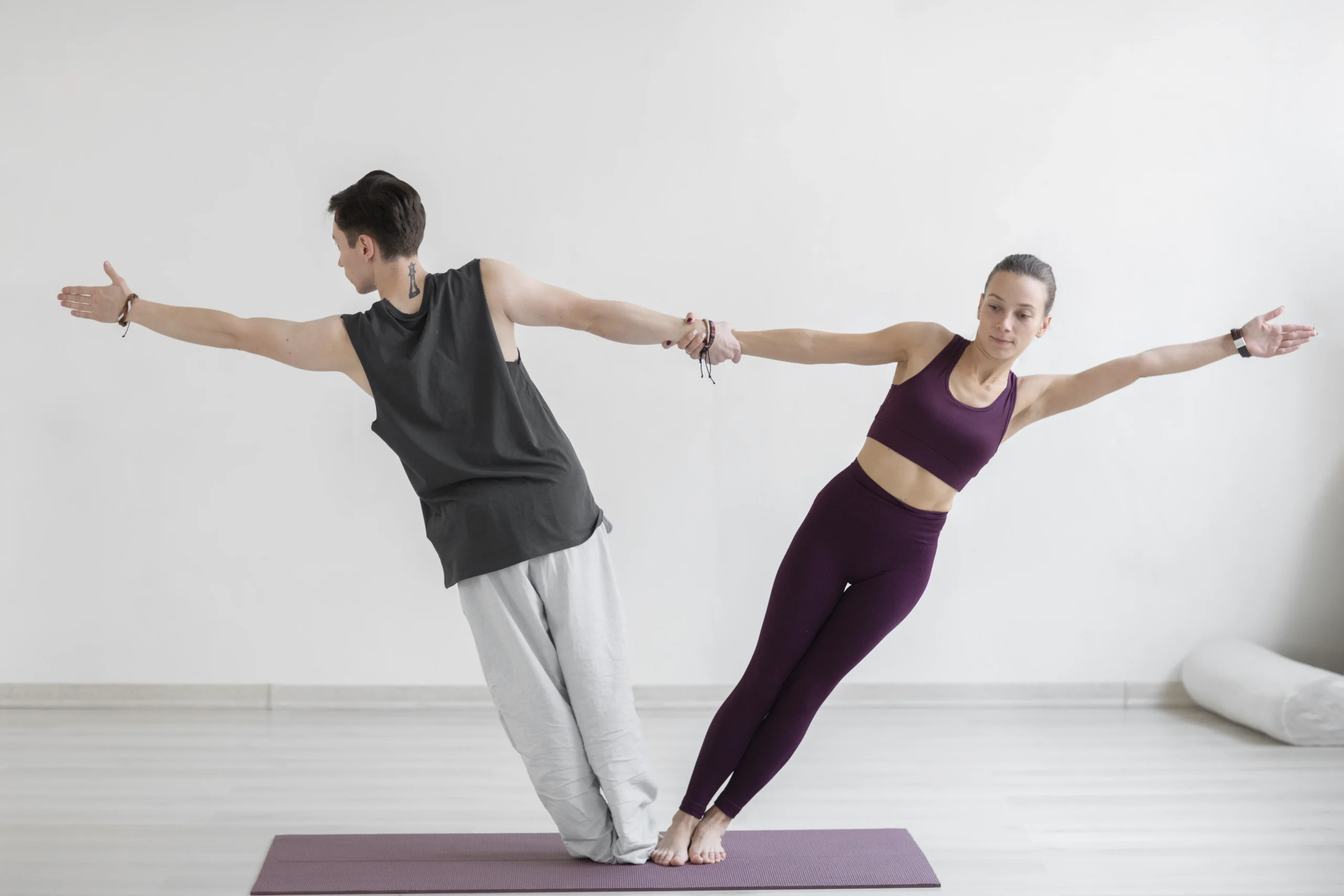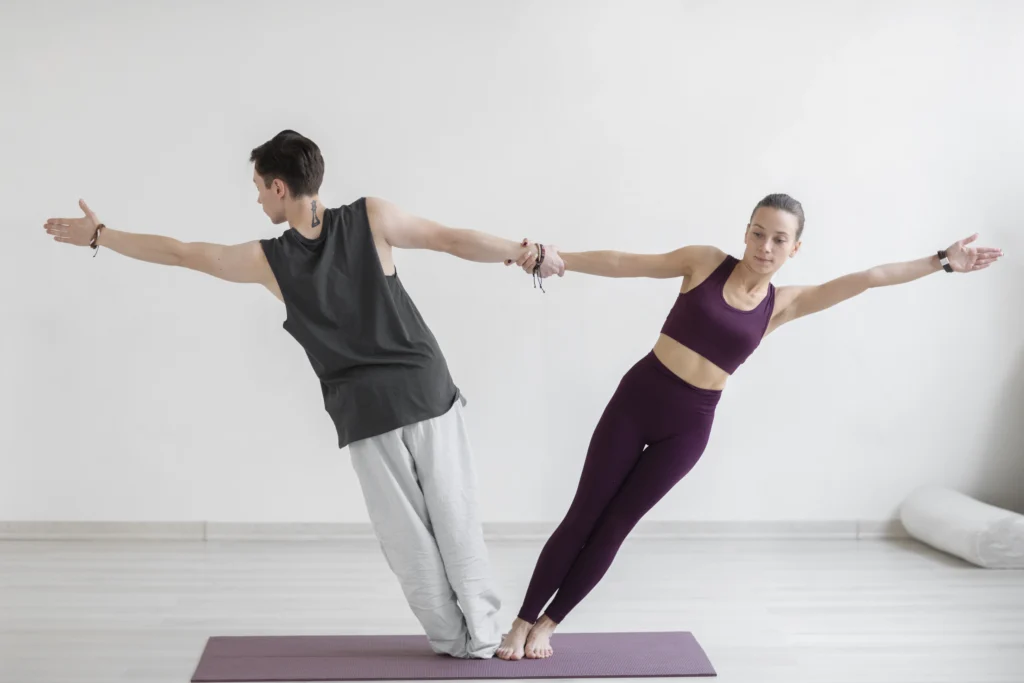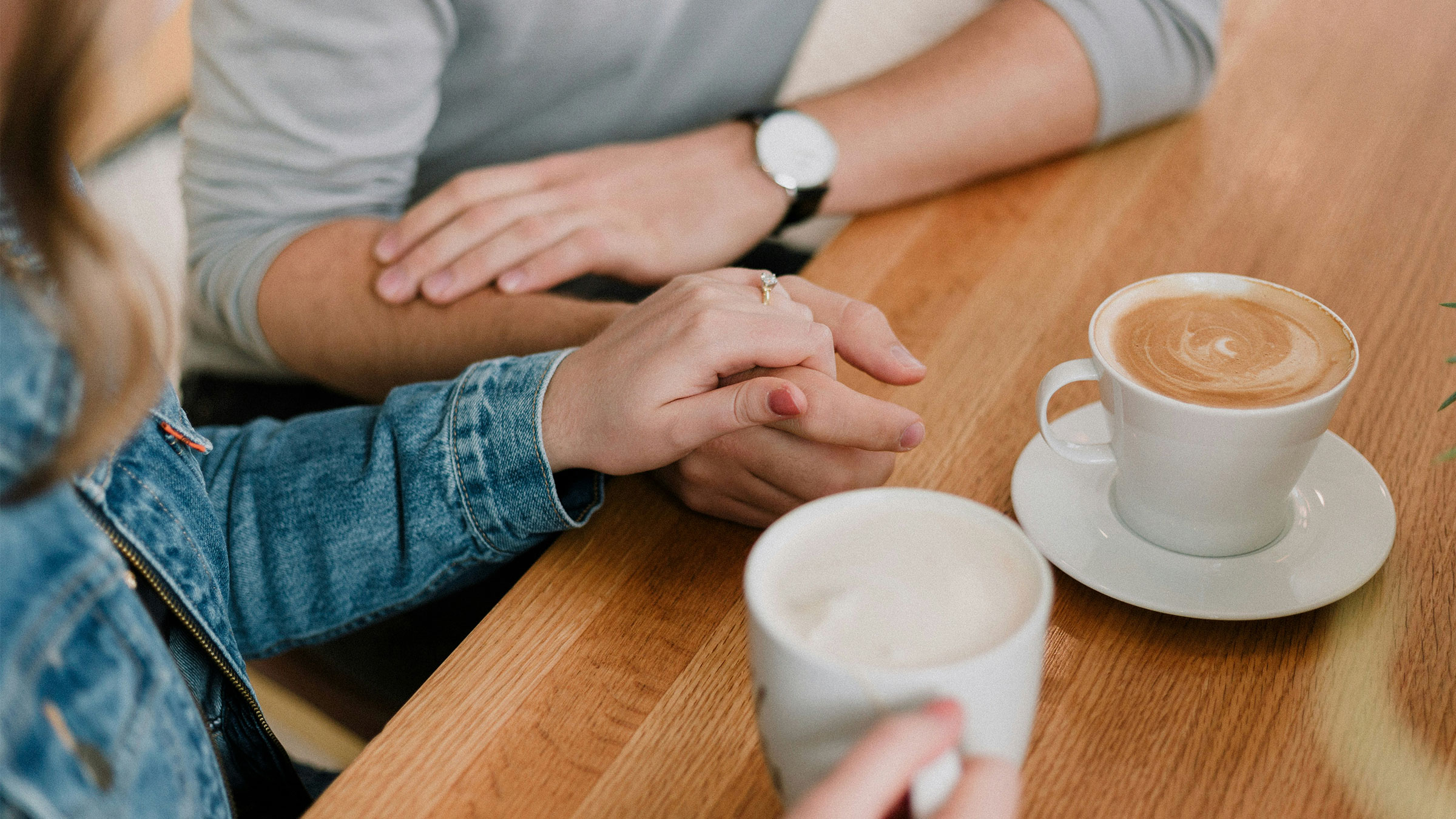9 Most Romantic Partner Yoga Poses for Couples (Try #5 Last!)
There’s magic in movement shared between two souls—where synchronized breaths become meditation, and intertwined bodies create healing connection. Partner yoga […]


There’s magic in movement shared between two souls—where synchronized breaths become meditation, and intertwined bodies create healing connection. Partner yoga poses for couples offers far more than physical flexibility; it’s a transformative practice that simultaneously nurtures your relationship and wellbeing.
Science confirms what yogis have known for centuries: partner yoga reduces stress hormones, lowers blood pressure, and boosts oxytocin (the “love hormone”) while improving mobility and posture. Whether you’re seeking to:
Relieve tension through therapeutic stretches Strengthen your bond through mindful touch Improve circulation and joint health with supported poses…these partner yoga poses for couples sequences meet you where you are. From gentle restorative postures that melt away stress to playful strength-building flows, each movement is designed to harmonize your energies while caring for your bodies.
💖 Bonus: Couples who practice together report better sleep, increased emotional attunement, and even enhanced intimacy—making this the ultimate self-care ritual for two.
(Discover the 9 most beneficial partner yoga poses for couples ahead—including #5, our favorite for back pain relief and heart-opening connection…)
Key Takeaways
Partner yoga boosts flexibility and emotional connection through synchronized movements. Even basic poses like Tree Pose or Shoulder Stand require communication and trust. Regular practice can reduce stress and improve coordination between partners. It’s accessible for all fitness levels when approached with patience. Creates lasting memories while fostering physical and emotional well-being.The Foundations of Partner Yoga
Practicing yoga with a partner can be rewarding. First, you need to master the basics. This ensures safety and strengthens your bond.
Safety first: Always check each other’s form to prevent injury. Open lines of communication: Use clear, calm words to guide adjustments. Alignment matters: Focus on posture to maximize benefits for both practitioners.Trust and clear communication are the pillars of any successful partner yoga session.
Start by learning each other’s yoga poses. Practice side by side to mirror movements before syncing up. This helps you get used to each other’s rhythm.
Sharing breaths in sync strengthens your teamwork. It turns poses into shared experiences. My own practice taught me patience and respect are key. They create a safe space for deeper connections.
These basics are crucial for every session. Without them, poses can become unbalanced. By focusing on these steps, couples build trust and grow together. The right foundation makes any practice a place where both partners can flourish.
Essential Partner Yoga Poses for Couples
Starting with gentle couples yoga poses builds trust and coordination. My favorite beginner sequence focuses on stability and teamwork. Try these three foundational poses to create a strong foundation.
1. Seated Cat-Cow (Synchronized Breathing) – A Partner Yoga Poses for Couples
The Seated Cat-Cow is a gentle yet powerful partner yoga poses for couples that helps couples sync their breath, warm up their spines, and build a deeper connection. It’s perfect for beginners and can be done anywhere—no yoga mat required!
Benefits of Seated Cat-Cow with a Partner
✅ Improves Spinal Flexibility – Mobilizes the spine and relieves tension in the back.
✅ Synchronizes Breathing – Encourages deep, coordinated breathing for relaxation.
✅ Enhances Emotional Bond – Physical touch and shared movement foster intimacy.
✅ Reduces Stress & Anxiety – Calms the nervous system through mindful breathing.
✅ Warms Up the Body – Prepares you for deeper yoga poses or meditation.
How to Do Seated Cat-Cow (Step-by-Step Guide)
1. Starting Position
Sit back-to-back with your partner in a cross-legged position (Sukhasana). Ensure your spines are aligned, and sit tall with your shoulders relaxed. Lightly press your backs together to feel each other’s presence.2. Synchronized Breathing
Take a few deep breaths together to establish a rhythm. Inhale and exhale at the same pace to create harmony.3. Cow Pose (Inhale – Backbend)
Inhale deeply as you both arch your backs. Lift your chests, roll your shoulders back, and tilt your heads slightly up. Press gently into each other’s backs for support. Feel your spines lengthen and your chests open.4. Cat Pose (Exhale – Forward Bend)
Exhale slowly as you round your spines. Tuck your chin to your chest, draw your belly in, and curve your back like a cat stretching. Feel your partner’s movement supporting your stretch.5. Repeat for 5-10 Rounds
Continue flowing between Cat (exhale) and Cow (inhale) in sync. Move slowly and mindfully, focusing on the connection with your partner.Tips for a Better Practice
✔ Press evenly into each other’s backs – This helps maintain balance.
✔ Keep your movements slow & controlled – Avoid jerky motions.
✔ Close your eyes – Enhances the sensory connection.
✔ Modify for comfort – Use a cushion under the hips if sitting cross-legged is uncomfortable.
2. Double Downward Dog Pose: A Fun Partner Yoga Variation
The Double Downward Dog is a playful and energizing partner yoga poses for couples that builds strength, flexibility, and connection between partners. It’s a variation of the classic Downward-Facing Dog (Adho Mukha Svanasana), where two people align their poses to create a mirrored or stacked effect.
Benefits of Double Downward Dog
✅ Deepens the Stretch – The stacked version adds gentle resistance, enhancing hamstring and shoulder flexibility.
✅ Improves Balance & Coordination – Requires focus and synchronization between partners.
✅ Strengthens Arms & Core – Both partners engage their upper body and core for stability.
✅ Encourages Playfulness & Trust – Laughing together over wobbles builds connection.
✅ Energizes the Body – Like traditional Downward Dog, it boosts circulation and relieves tension.
How to Do Double Downward Dog (Step-by-Step Guide)
Option 1: Mirroring (Side-by-Side)
Start in Downward Dog Individually – Both partners come into their own Downward Dog, facing the same direction, with about 2-3 feet of space between them. Lift One Leg – Simultaneously lift your right legs up (or left legs) toward the sky, keeping hips squared. Option to Connect – Gently touch your lifted feet together for balance and playfulness. Hold for 3-5 breaths, then switch legs.Option 2: Stacked (One Behind the Other)
Partner 1 (Base) – Starts in a strong Downward Dog, hands shoulder-width apart, feet hip-width apart. Partner 2 (Top) – Steps into their own Downward Dog behind Partner 1, placing their hands near Partner 1’s feet. Adjust Distance – Partner 2 walks their hands slightly forward so their body forms a straight line. Hold for 3-5 breaths, then release gently.Tips for Success
✔ Communicate – Adjust hand/feet placement if needed for comfort.
✔ Keep Core Engaged – Prevents sinking into the lower back.
✔ Modify as Needed – Beginners can keep knees slightly bent.
✔ Have Fun! – Falling or giggling is part of the experience.
3. Partner Forward Fold (Seated Stretch) – A Guide for Couples
The Partner Forward Fold (Seated Stretch) is a simple yet deeply connecting yoga pose for couples. It enhances flexibility, encourages relaxation, and fosters intimacy through synchronized movement and touch.
Benefits of Partner Forward Fold
✅ Deepens Hamstring & Lower Back Stretch – The mutual pull enhances flexibility.
✅ Improves Posture & Spinal Alignment – Encourages proper forward-folding mechanics.
✅ Encourages Synchronized Breathing – Promotes relaxation and connection.
✅ Builds Trust & Communication – Requires coordination and gentle guidance.
✅ Relieves Stress & Tension – Calms the nervous system when done mindfully.
How to Do the Partner Forward Fold (Seated Stretch)
Step-by-Step Instructions:
Sit Facing Each Other
Sit on the floor with your legs extended straight out in front of you. Press the soles of your feet together or keep them touching. Keep your spine tall and shoulders relaxed.Hold Hands or Forearms
Reach forward and hold your partner’s hands or forearms. Maintain a firm but gentle grip to support each other.Inhale & Lengthen Your Spine
Take a deep breath in, sitting up tall to create space in your spine.Exhale & Fold Forward
On an exhale, hinge at your hips (not your waist) and lean forward together. Keep your backs straight as you fold, leading with your chest. Go only as far as comfortable—no need to force the stretch.Hold & Breathe Together
Stay in the stretch for 5–10 breaths, syncing your breathing with your partner. Optionally, take turns gently pulling each other deeper into the stretch.Release Slowly
Inhale, engage your core, and slowly return to an upright position together.Tips for the Best Experience
✔ Communicate – Let your partner know if you need less or more stretch.
✔ Focus on Alignment – Keep spines long rather than rounding forward aggressively.
✔ Breathe Together – Synced breathing deepens relaxation and connection.
✔ Laugh & Enjoy – If you wobble or fall, it’s part of the fun!
4 Twin Trees Partner Pose
Twin Trees, also known as Partner Tree Pose, is a fun and engaging balancing yoga pose for couples. It requires teamwork, focus, and trust as you and your partner mirror each other in Tree Pose (Vrikshasana) while staying connected.
This pose is perfect for couples looking to improve their balance, coordination, and connection—both physically and emotionally.
Benefits of Twin Trees Pose
✅ Improves Balance & Stability – Standing on one leg strengthens ankles and core muscles.
✅ Enhances Focus & Mindfulness – Requires concentration to stay steady together.
✅ Builds Trust & Communication – Partners must synchronize movements and support each other.
✅ Strengthens Legs & Core – Engages the standing leg and abdominal muscles.
✅ Deepens Emotional Bond – Physical touch and shared energy create intimacy.
How to Do Twin Trees Pose (Step-by-Step Guide)
Step 1: Stand Side by Side
Stand hip-to-hip with your partner, facing the same direction. Keep a slight distance (about 6 inches apart) to allow space for movement.Step 2: Shift Weight onto One Leg
Both partners lift the same-side leg (e.g., both lift the right leg). Bend the knee and place the foot on the inner thigh or calf (avoid the knee joint).Step 3: Connect with Each Other
Wrap your same-side arm around each other’s waist or shoulders for support. Bring your free hands into Namaste (prayer position) at your chest or raise them overhead.Step 4: Find Your Balance
Gaze at a fixed point in front of you (drishti) to help with stability. Press your foot into your thigh and your thigh into your foot for engagement. Breathe deeply and sync your breath with your partner.Step 5: Hold & Switch Sides
Stay in the pose for 3-5 breaths (or longer if comfortable). Gently release and switch to the other leg.Tips for Success
✔ Start with a Wall – If new to balancing, stand near a wall for extra support.
✔ Use Light Touch – Holding each other’s shoulders or waist helps with stability.
✔ Laugh Off the Wobbles – Falling is part of the fun!
✔ Sync Your Breathing – Inhale and exhale together to enhance harmony.
5. Partner Boat Pose (Navasana): A Guide for Couples
Partner Boat Pose, or Double Boat Pose, is a fun and engaging yoga asana that strengthens the core, improves balance, and fosters connection between partners. This pose requires coordination, trust, and teamwork, making it a great way to bond while building strength.
Benefits of Partner Boat Pose (Navasana)
✅ Strengthens Core Muscles – Engages the abdominals, hip flexors, and lower back.
✅ Improves Balance & Coordination – Requires synchronized movement with your partner.
✅ Enhances Trust & Communication – Partners must work together to maintain stability.
✅ Stretches Hamstrings & Spine – Gentle stretch for the backs of the legs and spine.
✅ Boosts Confidence – Successfully holding the pose together creates a sense of achievement.
How to Do Partner Boat Pose (Step-by-Step Guide)
1. Starting Position
Sit facing your partner with knees bent and feet flat on the floor. Keep a slight distance so your toes touch when legs are extended.2. Connect with Your Partner
Hold each other’s forearms or hands for better stability. Engage your core and sit up tall to maintain a straight spine.3. Lift Your Legs
On an exhale, slowly lean back while lifting your feet off the ground. Straighten your legs so your bodies form a “V” shape. Keep your knees slightly bent if hamstrings are tight.4. Find Balance
Press your feet lightly against your partner’s for support. Gaze forward or at each other to help with balance. Hold for 5-10 breaths, maintaining steady breathing.5. Release Safely
Bend your knees and lower your feet back to the ground slowly. Relax and share a smile or high-five!Tips for Success
✔ Engage Your Core – Draw your navel in to stabilize the pose.
✔ Use Eye Contact – Helps with balance and connection.
✔ Start with Short Holds – Gradually increase duration as you build strength.
✔ Laugh & Have Fun – Falling is part of the process!
6. Double Plank (Partner Challenge)
The Double Plank is a fun yet challenging partner yoga poses for couples that tests your strength, balance, and teamwork. It’s a playful way to build core stability while deepening trust with your partner.
Benefits of Double Plank
✅ Strengthens Core & Arms – Both partners engage their abs, shoulders, and arms.
✅ Improves Balance – Requires coordination and stability.
✅ Builds Trust – The top partner relies on the base for support.
✅ Enhances Communication – Partners must adjust and communicate for proper alignment.
How to Do the Double Plank (Step-by-Step Guide)
Before You Start:
Warm up with some individual planks and core exercises. Ensure you have enough space and a non-slip surface (use a yoga mat). Communicate clearly with your partner throughout.Step 1: Base Partner Sets Up
Start in a forearm plank (on elbows) or a high plank (on hands), whichever feels more stable. Keep your core tight, hips level, and shoulders over wrists/elbows.Step 2: Flyer Partner Prepares
Stand near the base partner’s feet. Place your hands on their lower back/sacrum area (not the spine) for stability.Step 3: Flyer Enters the Plank
Carefully step one foot at a time onto the base partner’s upper thighs or hips (avoid the lower back). Engage your core and slowly shift weight forward until you’re in a floating plank position. Keep your body straight, like a regular plank.Step 4: Hold & Breathe
Both partners should engage their core and breathe steadily. Start with 10-20 seconds, then slowly increase as you gain confidence.Step 5: Safely Exit the Pose
The flyer should gently step down one foot at a time. Both partners can rest in Child’s Pose to recover.Tips for Success
✔ Strong Core – Both partners engage abs to stabilize.
✔ Light Feet – Flyer presses gently, avoiding heavy pressure.
✔ Short Holds First – Build endurance gradually (5–10 sec).
✔ Breathe Together – Sync breaths to stay balanced.
7 Supported Backbend (Heart Opener)
It is a beautiful partner yoga poses for couples that helps open the chest, shoulders, and heart space while building trust and connection between partners.
Benefits of Supported Backbend (Heart Opener)
✅ Opens the Chest & Shoulders – Counters hunching from sitting or phone use.
✅ Improves Posture – Stretches tight pectorals and strengthens the upper back.
✅ Deepens Trust & Connection – Requires vulnerability and support from your partner.
✅ Stimulates the Heart Chakra – Encourages emotional openness and compassion.
✅ Relieves Stress – Expands the ribcage, promoting deeper breathing.
How to Do It:
Starting Position
One partner (the “base”) stands tall with feet hip-width apart, knees slightly bent for stability. The other partner (the “backbender”) stands facing away, with their back close to the base.Preparation
The backbender raises their arms overhead, interlacing fingers if comfortable. The base places their hands on the backbender’s shoulder blades (not the lower back) for support.The Backbend
The backbender slowly leans back, keeping their core engaged. The base gently supports their weight, allowing them to deepen the backbend safely. The backbender can let their head relax back if comfortable, opening the throat.Hold & Breathe
Stay for 3-5 breaths, maintaining steady communication. To release, the backbender engages their core, and the base helps guide them back up slowly.Tips
⚠ Avoid This Pose If: You have severe back or shoulder injuries.
✔ Base Should: Keep knees slightly bent to avoid straining their lower back.
✔ Backbender Should: Engage their core to protect the spine.
8. Flying Warrior (Acro-Inspired Partner Yoga Pose)
The Flying Warrior is a dynamic and fun partner yoga poses for couples inspired by acro-yoga. It combines balance, strength, and trust, making it a thrilling yet challenging pose for couples. This pose is best suited for intermediate to advanced practitioners who have some experience with yoga or acrobatics.
Benefits of Flying Warrior Pose
✅ Builds Trust & Communication – Requires coordination and clear verbal/non-verbal cues.
✅ Strengthens Core & Legs – The base partner engages their legs, while the flyer activates their core.
✅ Improves Balance & Focus – Both partners must stay centered and aligned.
✅ Enhances Flexibility – The flyer gets a deep hip and hamstring stretch.
✅ Boosts Confidence – Successfully flying in this pose creates a sense of achievement.
How to Do Flying Warrior Pose (Step-by-Step Guide)
Roles:
Base Partner (on the ground, supporting the flyer) Flyer (the one being lifted)Step 1: Preparation
Warm up with some Sun Salutations and hip-opening stretches (like Pigeon Pose). Ensure you have a soft surface (yoga mat or grass) to prevent injuries.Step 2: Base Position
The base partner lies flat on their back, knees bent, feet flat on the floor (like a bridge pose setup). Arms are extended to the sides for stability.Step 3: Flyer’s Entry
The flyer stands at the base partner’s hips, facing their feet. Places hands on the base’s knees for support.Step 4: Lifting into Flying Warrior
Flyer leans forward, shifting weight onto the base’s feet. Base presses their feet firmly into the flyer’s hip crease/thighs to lift them. Flyer engages their core, extends one leg back (like Warrior 3), and stretches arms out (like an airplane).Step 5: Holding the Pose
Base keeps legs strong and steady. Flyer maintains a straight back and active core. Both partners breathe deeply and communicate for balance.Step 6: Coming Down Safely
Flyer slowly bends their standing leg and lowers down. Base gently guides them to the ground.Tips
Avoid if: You have back, hip, or wrist injuries. Base: Keep feet flexed, knees slightly bent. Flyer: Engage core, don’t lock knees.9 Partner Twist (Seated Spinal Detox)
Partner Twist, also known as Seated Spinal Detox, is a gentle yet effective yoga pose that helps release tension in the spine, improve digestion, and deepen the connection between partners. This twist is perfect for couples looking to unwind together while detoxifying their bodies and minds.
Benefits of Partner Twist (Seated Spinal Detox)
✅ Relieves Back & Neck Tension – The twisting motion helps loosen tight muscles along the spine.
✅ Stimulates Digestion – Twists massage internal organs, aiding digestion and detoxification.
✅ Improves Spinal Mobility – Enhances flexibility and reduces stiffness in the spine.
✅ Encourages Deep Breathing – Promotes relaxation and stress relief.
✅ Strengthens Connection – Synchronized movement fosters trust and harmony.
How to Do Partner Twist (Step-by-Step Guide)
Step 1: Sit Back-to-Back
Sit cross-legged (Sukhasana) or with legs stretched out (if more comfortable). Press your backs firmly together, ensuring your spines are aligned.Step 2: Sync Your Breath
Take a few deep breaths together to establish a rhythm.Step 3: Inhale & Lengthen
On an inhale, both partners lengthen their spines upward, sitting tall.Step 4: Exhale & Twist
On an exhale, one partner twists to the right, while the other twists to the left. Place your right hand on your partner’s left knee and your left hand behind you for support. Gaze over your shoulder to deepen the twist.Step 5: Hold & Breathe
Stay in the twist for 5-8 breaths, allowing the spine to release tension. With each exhale, gently deepen the twist (without forcing).Step 6: Release & Switch Sides
Inhale to come back to center. Repeat on the opposite side.Tips for a Better Partner Twist
✔ Keep backs connected – This provides stability and support.
✔ Move slowly – Avoid jerky movements to prevent strain.
✔ Use breath coordination – Twisting on the exhale helps deepen the stretch.
✔ Modify as needed – If sitting cross-legged is uncomfortable, try extending one or both legs.
Building Strength with Advanced Partner Yoga Poses for Couples
Advanced partner yoga poses take teamwork to the next level. Couples can build core strength and endurance by moving in sync. My own practice shows that poses like the Flying Bridge and Double Tree require focus and trust.
| Pose | Setup | Strength Focus |
| Flying Bridge | One partner bridges while the other holds feet. | Back and arm muscles |
| Double Tree | Stand back-to-back, bending sideways into a tree pose. | Legs and core stability |
| Partner Plank | Form a plank with hands interlocked, legs extended. | Full-body engagement |
Communication is key during advanced poses. Use clear cues like “lift together” or “bend slowly.” Start with modifications if needed—placing mats between you or using straps for stability. Safety tips include:
Align hips and shoulders before lifting Agree on a “reset” signal for discomfort Practice breath synchronizationThese poses push boundaries physically and emotionally. When my partner and I mastered the Flying Bridge, our coordination improved as much as our strength. Yoga for couples transforms workouts into moments of mutual growth, blending fitness with deeper connection.
Incorporating Yoga for Couples into Your Routine
Creating time for yoga poses for two needs regular effort. Begin by setting aside time each week, even just 15–20 minutes a day. Find a quiet spot at home with soft lighting and comfy mats. I’ve found that small, regular practices help build habits quicker than long sessions now and then.
Set a fixed time: mornings or evenings when stress is low Use props like blocks or straps to modify poses safely Track progress with a shared calendar to stay accountableTalking things over is important. Before you start, discuss what you both like. Some days might be gentle stretches, others balancing poses. Remember, getting better at yoga takes time. A certified instructor once said,
“Consistency in yoga for two nurtures trust and alignment—both physically and emotionally.”
Begin with simple poses. Try “tree pose” back-to-back, then add more challenging moves. Celebrate each small success, like holding a pose a bit longer. These moments strengthen your bond and your bodies. The aim isn’t to be perfect—it’s about showing up, breathing together, and growing together.
Enhancing Connection: Communication Techniques in Yoga
Good communication is key in yoga for partners. It helps in adjusting poses and setting boundaries. Clear talk builds trust and safety. I’ve seen couples improve their sessions by talking openly and without judgment.
Use clear verbal cues like “Bend deeper” or “Pause here.” Practice active listening—repeat your partner’s feedback to confirm understanding. Nonverbal signals, like a gentle hand on the shoulder, can guide without words.Begin by sharing your goals: “Today, I want to focus on balance.” This honesty opens the door for growth. Ask, “How does that feel?” during practice. This makes adjustments safer and more respectful.
Yoga for partners is more than just poses. It’s about listening to each other’s beats. Saying “Thank you for your patience” shows gratitude. It strengthens your bond, even off the mat.
“The best partner yoga isn’t about perfection—it’s about feeling seen and supported,” says yoga instructor Lila Chen. “These poses transform practice into a conversation of trust.”
Be patient with each pose. Focus on eye contact and verbal cues to enhance connection. Partner yoga poses for couples are more than exercises. They’re moments to breathe, listen, and grow together. Whether you’re new to yoga or seasoned, these practices show that intimacy grows in shared effort and presence.
Tailoring Your Practice: Customizing Yoga Poses for Partners
Every partnership is unique, so why not design yoga poses for partners that fit your needs? Start by assessing your strengths and limitations. If one partner is more flexible, choose poses that balance support and challenge. For example, modify Tree Pose by holding hands instead of clasping fingers overhead.
Adjust poses based on skill levels—use blocks or straps for stability. Swap roles regularly to ensure both partners share effort and focus. Set goals together, whether it’s improving balance or deepening trust.Communication is key. If a pose feels uncomfortable, pause and reposition. “Adaptation isn’t failure—it’s evolution,” says yoga instructor Lena Torres, emphasizing that flexibility extends beyond physical movement. Try short sessions to explore what feels right. Mix traditional poses with playful variations, like back-to-back Warrior III for a laugh and core workout.
Customizing yoga poses for partners keeps sessions engaging. Whether focusing on strength, flexibility, or fun, remember: there’s no “perfect” way. Celebrate small wins and stay open to change. Your practice grows stronger when it reflects your journey together.
Avoiding Common Pitfalls in Yoga Poses for Two
Mastering couples yoga poses means knowing common mistakes. Mistakes like bad alignment or poor communication can make poses risky. Here’s how to stay safe and connected:
Misalignment risks: Jumping into hard couples yoga poses without proper form can hurt your joints. Start with simple poses to build trust and awareness. Overexertion: Trying too hard can lead to injuries. Pay attention to your body’s signs—fatigue or pain means it’s time to stop. Ignoring communication: Not talking during poses can cause misunderstandings. Use words and eye contact to stay in sync.My experience shows that being clear and patient solves most problems. Try these tips:
Use mirrors to check alignment when doing couples yoga poses. Agree on a “pause” signal to stop poses quickly. Warm up together with simple stretches before moving on.“Trust grows when partners prioritize safety over perfection.” — Yoga Alliance
Conclusion
Partner yoga combines physical challenge with emotional connection. It’s a special way for couples to grow stronger together. My experience shows that it turns shared mats into spaces for trust and communication.
Every synchronized stretch or balanced pose is a step toward deeper intimacy. It’s about mutual support.
Start small with basic poses and build routines that fit your needs. Clear communication and respect for each other’s limits are key. Yoga for couples works best when it matches your relationship’s rhythm.
Even short weekly sessions can help your body and bond grow stronger. Begin your journey today. Unroll a mat, breathe in sync, and let yoga for couples guide your path to unity.
The poses are just the start. What matters most is the trust and joy you create along the way.
FAQ
Q1. What are some beginner-friendly partner yoga poses for couples?
Ans: Beginners can start with poses like Double Tree Pose, Partner Forward Bend, and Seated Cat-Cow Pose. These poses are great for learning together and building trust.
Q2. How can partner yoga improve my relationship?
Ans:Partner yoga boosts your relationship by improving communication and trust. It helps you connect on a deeper level, making your bond stronger.
Q3. What should I consider for safety during partner yoga sessions?
Ans:Always talk about your limits and comfort with your partner. Make sure you’re aligned right and use props if needed. Good communication is key to avoiding injuries and staying comfortable.
Q4. How can I fit yoga for couples into a busy routine?
Ans:To fit yoga into your busy life, start small and set realistic goals. Create a peaceful space at home and plan your yoga days. This way, you can make yoga a regular part of your week.
Q5. What common pitfalls should I avoid during partner yoga?
Ans:Avoid neglecting alignment, pushing too hard, and not listening to each other. Pay attention to your body and your partner’s signals. This ensures your sessions are safe and fun, avoiding frustration or injury.

 JaneWalter
JaneWalter 



















![The 2026 AI Search Benchmark Every SEO Leader Needs [Webinar] via @sejournal, @lorenbaker](https://www.searchenginejournal.com/wp-content/uploads/2025/11/1-259.png)









.jpg&h=630&w=1200&q=100&v=ebcc31501f&c=1)


